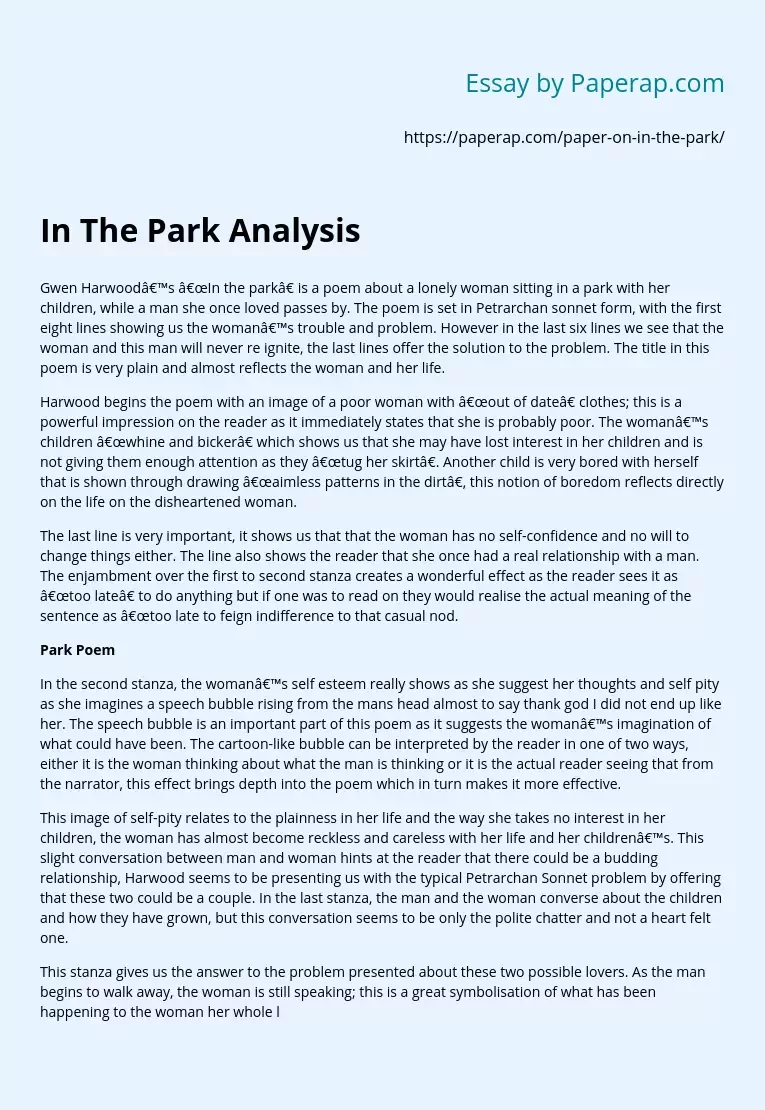Gwen Harwood’s “In the park” is a poem about a lonely woman sitting in a park with her children, while a man she once loved passes by. The poem is set in Petrarchan sonnet form, with the first eight lines showing us the woman’s trouble and problem. However in the last six lines we see that the woman and this man will never re ignite, the last lines offer the solution to the problem. The title in this poem is very plain and almost reflects the woman and her life.
Harwood begins the poem with an image of a poor woman with “out of date” clothes; this is a powerful impression on the reader as it immediately states that she is probably poor. The woman’s children “whine and bicker” which shows us that she may have lost interest in her children and is not giving them enough attention as they “tug her skirt”. Another child is very bored with herself that is shown through drawing “aimless patterns in the dirt”, this notion of boredom reflects directly on the life on the disheartened woman.
The last line is very important, it shows us that that the woman has no self-confidence and no will to change things either. The line also shows the reader that she once had a real relationship with a man. The enjambment over the first to second stanza creates a wonderful effect as the reader sees it as “too late” to do anything but if one was to read on they would realise the actual meaning of the sentence as “too late to feign indifference to that casual nod.
Park Poem
In the second stanza, the woman’s self esteem really shows as she suggest her thoughts and self pity as she imagines a speech bubble rising from the mans head almost to say thank god I did not end up like her. The speech bubble is an important part of this poem as it suggests the woman’s imagination of what could have been. The cartoon-like bubble can be interpreted by the reader in one of two ways, either it is the woman thinking about what the man is thinking or it is the actual reader seeing that from the narrator, this effect brings depth into the poem which in turn makes it more effective.
This image of self-pity relates to the plainness in her life and the way she takes no interest in her children, the woman has almost become reckless and careless with her life and her children’s. This slight conversation between man and woman hints at the reader that there could be a budding relationship, Harwood seems to be presenting us with the typical Petrarchan Sonnet problem by offering that these two could be a couple. In the last stanza, the man and the woman converse about the children and how they have grown, but this conversation seems to be only the polite chatter and not a heart felt one.
This stanza gives us the answer to the problem presented about these two possible lovers. As the man begins to walk away, the woman is still speaking; this is a great symbolisation of what has been happening to the woman her whole life. It is as if the woman has never finished anything off and suggests that she usually is trying to bring things together and putting the last word in. After the man has left her presence, the woman is “nursing the youngest child” and shows the reader the real reason for most of her woes.
She speaks to the wind, which again reflects her state of mind and refers to her children, “they have eaten me alive”. This last line of the poem is a powerful image of blame, not on her but on others. Harwood’s “in the park” portrays a woman whose life is in a downward spiral and becoming lifeless. The woman in the poem who is suggestively not named has been in love but is now out of it. The poem shows the reader how the woman’s continuous negative output seems to upset all people around her.
In The Park Analysis. (2019, Dec 05). Retrieved from https://paperap.com/paper-on-in-the-park/

